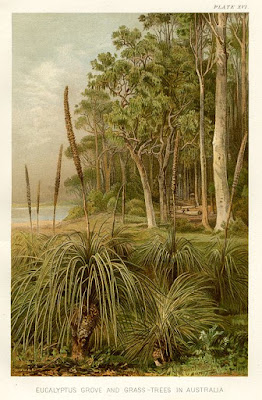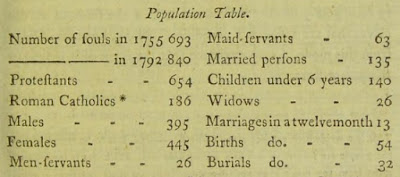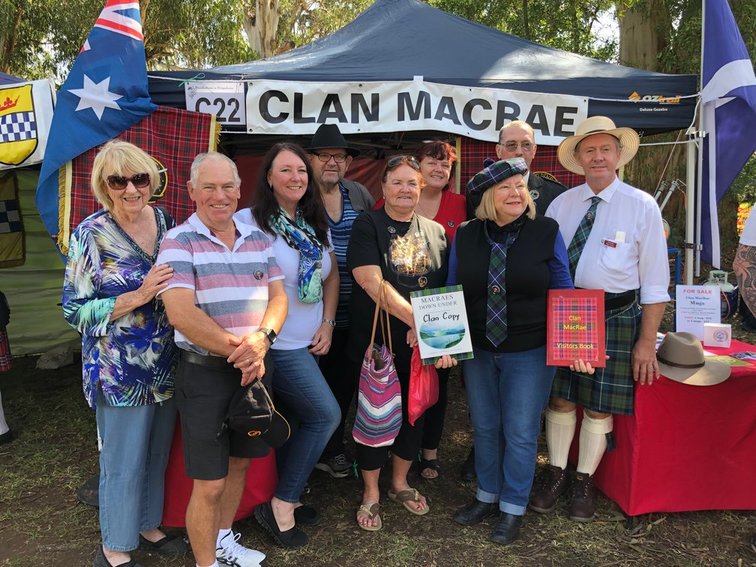Reaching out to Farquhar's Descendants
Arrival
 |
| taken from near Eilean Donan Castle looking to Isle of Skye |
On 27 October 1837, Farquhar MacRae, arrived in Port Jackson, Sydney, on the ship William Nicol. This was the first ship of Government Assisted immigrants to sail from Scotland to Australia. (The William Nicol was entirely funded by the British Government from the sale of Crown land in the Colony of NSW. It was not funded by colonists, so therefore did not sail under the bounty system.) The journey took 113 days and covered approximately 13,000 nautical miles. Farquhar came with his daughter Mary from the his first marriage to Flora MacRae, his second wife Barbara McLennan and their son John. By 1854, Farquhar and Barbara will have added nine more children to their family.
Also on board the "William Nicol" was Farquhar's first cousin Alexander MacRae with his wife Ann Beaton and their daughter Hellen (or Ellen).
The two MacRaes families remained close, especially in the early years, both geographically and through marriage; Farquhar's granddaughter Flora Rankin married Alexander's grandson James Samuel. To this day, there remains a connection, although small, between the descendants of Farquhar and the descendants of Alexander.
One hundred and eighty years have now passed since Farquhar's arrival. His descendants are many and their surnames varied. Are you a descendant of Farquhar? Do you have a story to contribute? Please contact us.
A New Way of Life Begins
Many things were going to be different in Australia from their life in Scotland. Many adjustments were to be made.They weren't though, by any means, the first Scots to arrive in the Colony. As well as a few convicts including the "Scottish Martyrs", Thomas Muir and William Skirving transported in 1794, a number of prominent merchants of the 1790s, Robert Campbell, Alexander Berry and Archibald Mosman, the Governor of N.S.W. from 1809 to 1824, Lachlan Macquarie, from the Highlands, and of course, Rev. John Dunmore Lang who played an important role in the immigration of Scottish Highlanders. However, not many amongst those who arrived before 1837 would have been Catholic, Gaelic speaking Highlanders.
From an article in the Sydney Monitor, 17 November 1837, we know that on arrival, they were free to arrange employment with whomever they chose, on whatever terms they could arrange. But unlike the passengers on the next ship of Highlanders, the "Midlothian", who were all settled in the Hunter valley, the passengers on the "William Nicol" were engaged in various locations, dispersed amongst 29 different employers.
 |
| Rations given with Employment |
Whether Duncan McLennan was a close relative of Farquhar's wife Barbara and what became of the families of Dugald McKenzie and Duncan McLennan is not known.
The passenger list also states the conditions of employment. The MacRaes and Dugald McKenzie were to receive £30 per annum, plus rations and Duncan McLennan was employed on an unstated daily rate. An article published in The Australian, 12 June 1838, describing the conditions of employment states that "The wages given to farm servants vary so much according to their qualifications, that it is difficult to name an average rate. A good ploughman will earn from £15 to £20 per annum; with a house and rations. Shepherds and stockmen the same. Mere agricultural labourers from £12 to £15.". So it can be seen that the Highlanders were employed on comparatively good rates.
This same article describes the rations that were included in the terms of employment. It is notable that oats, an important part of the traditional Highlander diet, are not included. One hopes that the MacRaes were able to make arrangements to get an adequate supply. Today, there are at least a few of Farquhar's descendants that have kept this Highlander tradition alive and love their oatmeal porridge.
Lets now look briefly at how the MacRae's lives would be transformed by their new surroundings in the following areas: Natural Environment, Housing, Dress, Language and Religion.
Natural Environment
 |
| Eucalyptus Grove and Grass-Trees in Australia from The Natural History of Plants, 1896, chromolithograph: Size 13 x 21 cms, printed in Leipzig by the Bibliographisches Institut Steve Bartrick Antique Prints and Maps |
The coolest weather on the plains west of Sydney, where they first lived in Australia, is more akin to Scottish spring or autumn.
Due to the high latitude of Ross‑shire the amount of daylight varies considerably depending on the time on the year. In winter, around December, January, the days are short with only about four hours of dim daylight. Then during the summer months around May, June the days are long with 18 daylight hours. In the Sydney region, being closer to the equator, the difference in the number of daylight hours fluctuates less, from nine to 14 hours.
Arriving at the end of October, in mid spring, with wild flowers blooming and moderate weather, gave the MacRaes little time to adjust to the heat of their first Australian summer. The women too would have been effected by the heat. Some of us can remember our mothers cooking a baked dinner on a wood burning stove in the middle of summer. The kitchen became so uncomfortably hot that it was cooler in a shady spot outdoors.
These differences in climate and daylight hours effect how people work. The milder winters with longer days are more productive. By contrast the heat of summer makes outdoor work more difficult, especially in the midday sun, at least until acclimatized. And the MacRaes or at least their descendants did acclimatize as there now a considerable number living on the Central Coast of N.S.W., up into Queensland on the Gold Coast and in Brisbane.
 |
| extract from Topographical Appearances The New Statistical Account of Scotland, Kintail, Ross and Cromarty, Vol. 14, 1845 p.171. |
The Australian landscape has it's own beauty but is quite unlike that of Kintail. The country abounds with flora and fauna uniquely Australian. No "mountains of immense magnitude, grouped together in the sublimest of manner". Nor are there Marten and Deer, nor Scots Firs, Willows and Whitebeams, nor Primrose and Heather but Australia does now have the Scottish Spear Thistle.
Housing
 |
| A Highland Clachan Loch Duich, Ross-shire, 2883 G.WW, Photograph Album No.33: Courtauld Album Canmore National Record of the Historic Environment |
These houses had external double walls of dry stone typically packed with earth or pebbles, broad at the base and narrowing towards the top, with rounded corners, wooden rafters supporting a thatched roof and no windows nor chimney. Often buildings were built close together and shared a common wall.
This style of housing had some advantages. In the centre of the living area a peat fire burned continually on an open hearth, filling the house with smoke that slowly escaped through the roof. The smoke kept the bugs and vermin away and covered the smell of the animals. The soot from the smoke also enriched the thatch which was usually replaced annually when the old soot-covered thatch was used for fertilizer. The urine from the animals produced ammonia which sterilised the house and the thick double walls kept the warmth in and withstood the wind.
In Australia they would be living in a smaller wooden house, with a wooden floor, a chimney and windows perhaps only with shutters though, not glass. As the climate is warmer, livestock are able to remain outdoors all year round, and much less fuel is need to prepare food and keep warm. The fuel was also different. Instead of peat there was an ample supply of wood to burn. In Australia it would be the hot weather and the often limited water supply that was difficult to endure rather than the cold.
 |
| Settler's Hut in Australia |
Dress
Following Jacobite Revolution and the Battle of Culloden, Acts of Parliament had banned the wearing of Highlander clothing, such as kilts, trews and plaid, and the playing of bagpipes, except for army regiments. In 1782 these laws were repealed but it wasn't really until the visit to Scotland of King George IV in 1822 that tartan experienced a fashionable revival. Everyone was "discovering" a Clan tartan and wearing Highlander clothing even those whose ancestral background probably meant they didn't belong to a clan or hail from the Highlands. So at the time of the MacRae's emigration one imagines them boarding the ship dressed in Highlander clothes much as the three examples pictured here from the book "The Clans of the Scottish Highlands" published in 1845.
| Robert Ronald McIan
Clan Matheson, Clan MacRae and Clan McLeod lithograph from Watercolour, 52cm x 39cm from James Logan's "The Clans of the Scottish Highlands", published in 1845 Drennan Edinburgh |
Language
It is quite possible, in 1837 when the MacRaes left Scotland, given the Clan MacRae history of learned church ministers and bards (poets), that Farquhar and Alexander knew some English, and also being Roman Catholics, they may have known some Latin.
 |
| Language of the People The New Statistical Account of Scotland, Kintail, Ross and Cromarty, Vol. 14, 1845 p.177. |
For the women, it seems less likely that they knew anything other than Gaelic as the journal of Dr. Roberts, the ships surgeon, records that the "mothers in general knew Gaelic only".
Lack of language skills can make the simplest of tasks challenging. Whatever English they arrived with, would have due to the circumstances, improved reasonably quickly. Being separated from most of the other Highlanders that came on the "William Nicol", would have necessitated mixing and communicating with people of various backgrounds and cultures with English being the common language.
Do you know what language skills the MacRaes had at the time of their arrival? Let us know.
Religion
 |
| Population Table The Statistical Account of Scotland, Kintail, Ross and Cromarty, Vol. 6, 1793, p. 251. |
In spite of difficulties and the continued emigration of Catholics, largely to America and Canada, in "The Catholic Highlands of Scotland", Frederick Odo Blundell, states that in 1822 "The daughter mission of Kintail continued to prosper.". Writing in 1916, Frederick Blundell based his work on letters in the archives of the Propaganda, a committee of cardinals of the Roman Catholic Church founded in 1622 by Pope Gregory XV who were responsible for foreign missions.
 |
| The daughter mission of Kintail, Knoydart |
Given the situation in the Highlands, the MacRaes would have been accustomed to living with people who followed a different religion. Perhaps being Catholic in Australia, rather then members of Scottish or Presbyterian Church, made it easier for them to find a place of worship, as there were also many Catholic Irish immigrants and emancipated convicts already in the Colony. They need not have been living in a community of Catholic Scots to find a place of worship. The 1836 census for the Colony of N.S.W. records 54,621 Protestants, 21,898 Catholics, 477 Jews and 100 Pagans; the country of origin was not recorded. There was a total population of 77,096 of which 27,831 were convicts. The population of greater Sydney including Parramatta, Liverpool and Woronora was 19,420, with Sydney alone having 16,260 residents.
Many thanks to all the family historians who have kept the story of the MacRaes alive.
 |
| James Taylor, Panorama du Port Jackson et de la ville de Sidney, 1824, 1 print : aquatint, hand coloured, 14.5 x 96 cm, chez Nepveu et : chez Rittner et Goupil, Paris (Passage de Panoramas no. 26; Boulevard Montmartre no. 9), National Library of Australia |
Mentioned on this page (in the order mentioned)
● Prentis, Malcolm, 2008, "Scots", Dictionary of Sydney, viewed 30 Oct 2017, http://dictionaryofsydney.org/entry/scots
● 1837 'Immigration.', The Sydney Monitor (NSW : 1828 - 1838), 17 November, p. 4. (EVENING), viewed 05 Nov 2017, http://nla.gov.au/nla.news-article32158062
● 1838 'ENCLOSURE', The Australian (Sydney, NSW : 1824 - 1848), 12 June, p. 1. (Supplement to "The Australian."), viewed 05 Nov 2017, http://nla.gov.au/nla.news-article36854074
● 1845 Gordon, J. ed., "Topographical Appearances", The New Statistical Account of Scotland / by the ministers of the respective parishes, under the superintendence of a committee of the Society for the Benefit of the Sons and Daughters of the Clergy. Kintail, Ross and Cromarty, Vol. 14, Edinburgh: Blackwoods and Sons, p. 171. Internet Archive, viewed 10 Nov 2017, https://archive.org/stream/b21365805_0014#page/170/mode/2up
● "Australian Hut", Illustrated London News, 17 March, p. 184. The Illustrated London News Historical Archive, 18422003, viewed 08 Nov 2017, tinyurl.galegroup.com/tinyurl/5TZcV2 [State Library of NSW Library card or similar required to view online]
● McIan, R. R., and Logan, James, 1845, "The Clans of the Scottish Highlands", Ackerman & Co., Internet Archive, viewed 26 Oct 2017, archive.org/download/mcianscostumesc00mciagoog/mcianscostumesc00mciagoog.pdf
● 1845 Gordon, J. ed., "Language of the People" and "Parochial Registers", The New Statistical Account of Scotland / by the ministers of the respective parishes, under the superintendence of a committee of the Society for the Benefit of the Sons and Daughters of the Clergy. Kintail, Ross and Cromarty, Vol. 14, Edinburgh: Blackwoods and Sons, p. 177. Internet Archive, viewed 10 Nov 2017, https://archive.org/stream/b21365805_0014#page/176/mode/2up
● Roberts, George, R.N. Surgeon and Superintendent, 1837, "Medical and surgical journal of the William Nicol emigrant ship for 3 July to 28 October 1837", viewed 28 Oct 2017, The National Archives of United Kingdom, http://discovery.nationalarchives.gov.uk/browse/r/h/C4107037
● 1793 Sinclair, Sir John. "Population Table", The Statistical Account of Scotland, Kintail, Ross and Cromarty, Vol. 6, Edinburgh: William Creech, p. 251, Internet Archive, viewed 14 Nov 2017, https://archive.org/stream/b21365799_006#page/250/mode/2up
● 1917 Bundel, Odo. "Knoydart", The Catholic Highlands of Scotland, The Western Highland and Islands, Sands & Co. p. 83-84., viewed 15 Nov 2017, https://archive.org/stream/catholichighland02blunuoft#page/n107/mode/2up
● HCCDA Document 'NSW-1836-census', The Historical Census and Colonial Data Archive (HCCDA) - Australian Colonial census, pg 83 and 84, viewed 03 Nov 2017, http://hccda.ada.edu.au/pages/NSW-1836-census-01_83
Further reading
● Blackhouse Museum, Undiscovered Scotland, viewed 12 Nov 2017, http://www.undiscoveredscotland.co.uk/lewis/blackhousemuseum/index.html
● "Highland Dress", Scottish Tartans Authority, viewed 29 Oct 2017, http://www.tartansauthority.com/highland-dress/
● Katherine Foxhall, 'Fever, Immigration and Quarantine in New South Wales, 1837–1840', Social History of Medicine Vol. 24, Issue 3, pp. 624–642, viewed 21 July 2019, https://academic.oup.com/shm/article/24/3/624/1641803.
● 2013 Khushboo Sood, Blackhouse - vernacular architecture, 22 October, viewed 12 Nov 2017, https://www.slideshare.net/khushboosood/blackhouse-vernacular-architecture
● "Third period: sixteenth century to the present day", Scotland, New Advent, Catholic Encylopeadia, viewed 15 Nov 2017, http://www.newadvent.org/cathen/13613a.htm
● Prentis, Malcolm, 2008, "Scots", Dictionary of Sydney, viewed 30 Oct 2017, http://dictionaryofsydney.org/entry/scots
● 1837 'Immigration.', The Sydney Monitor (NSW : 1828 - 1838), 17 November, p. 4. (EVENING), viewed 05 Nov 2017, http://nla.gov.au/nla.news-article32158062
● 1838 'ENCLOSURE', The Australian (Sydney, NSW : 1824 - 1848), 12 June, p. 1. (Supplement to "The Australian."), viewed 05 Nov 2017, http://nla.gov.au/nla.news-article36854074
● 1845 Gordon, J. ed., "Topographical Appearances", The New Statistical Account of Scotland / by the ministers of the respective parishes, under the superintendence of a committee of the Society for the Benefit of the Sons and Daughters of the Clergy. Kintail, Ross and Cromarty, Vol. 14, Edinburgh: Blackwoods and Sons, p. 171. Internet Archive, viewed 10 Nov 2017, https://archive.org/stream/b21365805_0014#page/170/mode/2up
● "Australian Hut", Illustrated London News, 17 March, p. 184. The Illustrated London News Historical Archive, 18422003, viewed 08 Nov 2017, tinyurl.galegroup.com/tinyurl/5TZcV2 [State Library of NSW Library card or similar required to view online]
● McIan, R. R., and Logan, James, 1845, "The Clans of the Scottish Highlands", Ackerman & Co., Internet Archive, viewed 26 Oct 2017, archive.org/download/mcianscostumesc00mciagoog/mcianscostumesc00mciagoog.pdf
● 1845 Gordon, J. ed., "Language of the People" and "Parochial Registers", The New Statistical Account of Scotland / by the ministers of the respective parishes, under the superintendence of a committee of the Society for the Benefit of the Sons and Daughters of the Clergy. Kintail, Ross and Cromarty, Vol. 14, Edinburgh: Blackwoods and Sons, p. 177. Internet Archive, viewed 10 Nov 2017, https://archive.org/stream/b21365805_0014#page/176/mode/2up
● Roberts, George, R.N. Surgeon and Superintendent, 1837, "Medical and surgical journal of the William Nicol emigrant ship for 3 July to 28 October 1837", viewed 28 Oct 2017, The National Archives of United Kingdom, http://discovery.nationalarchives.gov.uk/browse/r/h/C4107037
● 1793 Sinclair, Sir John. "Population Table", The Statistical Account of Scotland, Kintail, Ross and Cromarty, Vol. 6, Edinburgh: William Creech, p. 251, Internet Archive, viewed 14 Nov 2017, https://archive.org/stream/b21365799_006#page/250/mode/2up
● 1917 Bundel, Odo. "Knoydart", The Catholic Highlands of Scotland, The Western Highland and Islands, Sands & Co. p. 83-84., viewed 15 Nov 2017, https://archive.org/stream/catholichighland02blunuoft#page/n107/mode/2up
● HCCDA Document 'NSW-1836-census', The Historical Census and Colonial Data Archive (HCCDA) - Australian Colonial census, pg 83 and 84, viewed 03 Nov 2017, http://hccda.ada.edu.au/pages/NSW-1836-census-01_83
Further reading
● Blackhouse Museum, Undiscovered Scotland, viewed 12 Nov 2017, http://www.undiscoveredscotland.co.uk/lewis/blackhousemuseum/index.html
● "Highland Dress", Scottish Tartans Authority, viewed 29 Oct 2017, http://www.tartansauthority.com/highland-dress/
● Katherine Foxhall, 'Fever, Immigration and Quarantine in New South Wales, 1837–1840', Social History of Medicine Vol. 24, Issue 3, pp. 624–642, viewed 21 July 2019, https://academic.oup.com/shm/article/24/3/624/1641803.
● 2013 Khushboo Sood, Blackhouse - vernacular architecture, 22 October, viewed 12 Nov 2017, https://www.slideshare.net/khushboosood/blackhouse-vernacular-architecture
● "Third period: sixteenth century to the present day", Scotland, New Advent, Catholic Encylopeadia, viewed 15 Nov 2017, http://www.newadvent.org/cathen/13613a.htm











